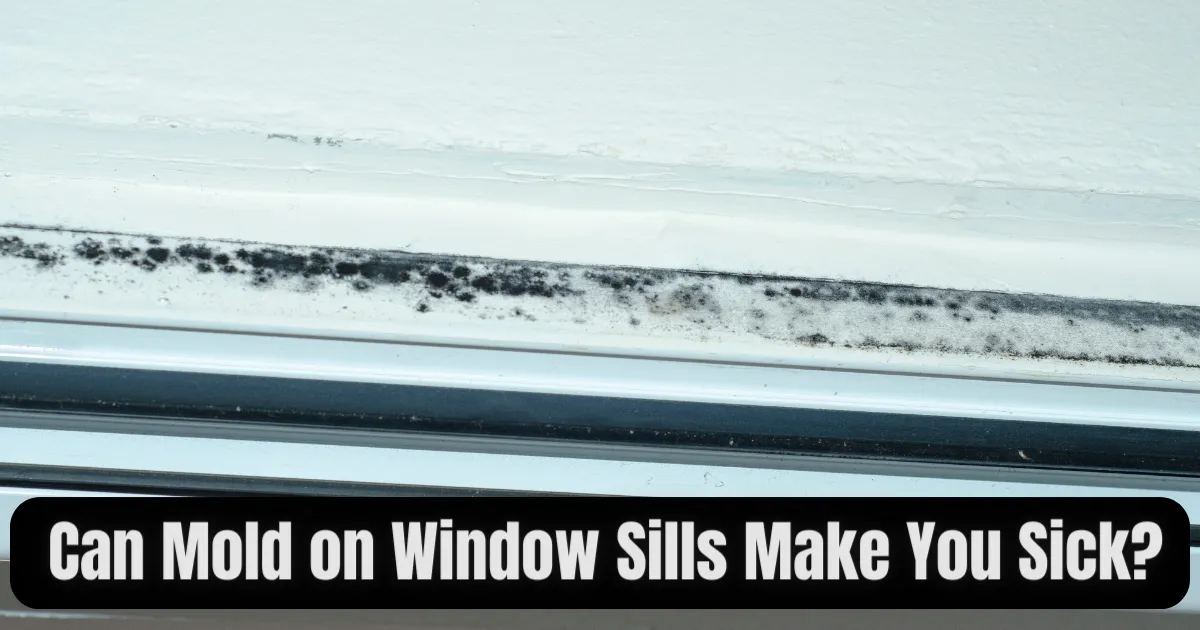Welcome to our informative discussion about “Can Mold on Window Sills Make You Sick?” Mold is a common issue found in our homes, especially in damp and poorly ventilated areas like window sills. Although mold can not be detected easily it can affect our health so it can not be overlooked.
In this article, we will explore the effect of mold on windows sills and analyze whether it has any potential to make you sick. Identifying the dangers of mold growth may help you to take proactive steps and create a healthier environment for yourself and your loved ones. So let’s get started and clarify this crucial issue!
Contents
- 1 Can Mold on Window Sills Make You Sick?
- 2 Types of mold on window sills
- 3 Why does mold grow on window sills?
- 4 Health Risks Associated with Mold:
- 5 What to consider before cleaning mold from your window sills?
- 6 How to Remove Mold from Window Sills?
- 7 How to prevent mold to grow on window sills?
- 8 Conclusion
- 9 FAQs
- 10 You may also read:
Can Mold on Window Sills Make You Sick?

Mold is a fungus that can grow in moist, warm environments. It can be found inside your house, but window sills are where you’re most likely to find it. You might be wondering if mold on your window sills might make you sick.
The answer is yes, especially if you have allergies or asthma, mold on window sills can make you sick. Allergens, irritants, and harmful substances known as mycotoxins can all be produced by mold. Numerous symptoms, such as respiratory issues, skin issues, eye issues, headaches, nausea, and fatigue, can be caused by these.
It’s important to have your window sills examined by a specialist if you suspect mold growth there. If mold is found, it must be removed as soon as possible to avoid further health issues.
Types of mold on window sills

Different types of mold can be found on window sills, Some common types are:
Aspergillus: This type of mold is often found in food and soil. It can produce irritants and allergies as well as serious medical problems in some people.
Penicillium: This is a type of mold that is often used to make antibiotics. It can also produce allergens and irritants, but it is generally not considered to be as harmful as Aspergillus.
Cladosporium: The type of mold is normally found in outdoor environments. Although it has the ability to create allergens and irritants, Penicillium is generally not considered to be as dangerous as Aspergillus and Penicillium.
Stachybotrys chartarum: This mold is also known as “Black Mold”. It can produce mycotoxins, which are toxic substances that can cause a variety of health problems, including respiratory problems, skin problems, and neurological problems.
Why does mold grow on window sills?

Mold grows on window sills due to several reasons that create a favorable environment for their growth.
- Moisture: Window sills are often exposed to moisture from condensation. When warm indoor air comes into contact with a cold window surface, it cools down, and the moisture in the air condenses on the cooler glass. Over time, this continuous cycle of condensation can create a damp environment on the window sill, promoting mold growth.
- Poor ventilation: Poor ventilation may make the moisture issue worse. If the room doesn’t have enough airflow, moisture from condensation or other sources (such as high humidity) may remain on the window sill, which can encourage the growth of mold.
- Organic matter: On window sills, dirt, dust, and debris gather up over time. These organic substances can serve as a source of food for mold, providing it with the nutrients it requires to grow and develop.
- Lack of sunlight: In areas that receive direct sunshine, mold is less likely to grow because it favors dark environments. Sills might not receive enough sunlight to prevent the spread of mold, particularly in rooms that are covered or face north.
- Indoor humidity: High indoor humidity levels, especially during warm weather or in rooms without proper ventilation, can contribute to mold growth on window sills and other surfaces in the home.
- Leaks and water intrusion: In some cases, leaks around windows or in the walls near the window can introduce additional moisture to the window sill area, creating an even more conducive environment for mold growth.
Health Risks Associated with Mold:

Numerous diseases might arise from mold exposure, especially for those who are sensitive, allergic, or who already have certain diseases. The following diseases are associated with exposure to mold:
- Respiratory Problems: Mold spores and mycotoxins released by mold can be inhaled and irritate the respiratory system. This can lead to symptoms such as coughing, wheezing, shortness of breath, and aggravation of asthma in susceptible individuals.
- Allergic Reactions: Mold is a common allergen, and exposure to mold spores can trigger allergic reactions in some people. Symptoms may include sneezing, runny or stuffy nose, itchy or watery eyes, and skin rashes.
- Sinusitis and Nasal Congestion: Prolonged exposure to mold can lead to chronic sinusitis, which causes inflammation and congestion in the nasal passages.
- Skin Irritation: Contact with mold or moldy surfaces can cause skin irritation, redness, itching, and rashes in some individuals.
- Headaches and Fatigue: Some people exposed to mold may experience persistent headaches and fatigue.
- Respiratory Infections: In individuals with weakened immune systems or underlying respiratory conditions, exposure to mold can increase the risk of developing respiratory infections.
- Hypersensitivity Pneumonitis: This is a rare but serious condition that results from an immune system response to mold or other airborne particles. It causes inflammation in the lungs and can lead to severe respiratory problems.
- Asthma Exacerbation: For individuals with asthma, exposure to mold can trigger asthma attacks and worsen asthma symptoms.
- Opportunistic Infections: Certain types of mold, such as Aspergillus, can cause opportunistic infections in people with compromised immune systems.
- Toxic Mold Exposure: Some molds produce mycotoxins, which are toxic substances that can be harmful if ingested, inhaled, or come into contact with the skin. Toxic mold exposure can lead to more severe health problems, depending on the type and amount of mycotoxins present.
What to consider before cleaning mold from your window sills?

It is important to consider the following factors before cleaning mold from your windows sills.
Protective Gear: While cleaning, mold can release spores and potentially dangerous compounds. To avoid direct contact with mold and reduce the risk of inhalation, wear proper protective gear, such as an N95 respirator mask, safety goggles, gloves, and long sleeves or pants.
Ventilation: Ensure proper ventilation in the area while cleaning. Open the windows and use fans to exhaust air outside. This will help you to prevent the concentration of mold spores in the room during cleaning.
Identify the Source: Try to identify the source of the mold growth. If the mold is due to a leak or water intrusion, it’s important to address the source of moisture first to prevent mold from returning after cleaning.
Extent of Contamination: Analyze the windows and the surrounding areas’ mold growth to see how bad it is. The most effective method to follow for secure and effective removal of mold is to hire a professional mold removal service if the affected area is sizable (over 10 square feet) or if mold is found inside the wall.
Cleaning Solutions: Use proper cleaning solutions to remove mold from the window. Mild detergent, baking soda, or a mixture of water and vinegar can be effective for cleaning small areas. Avoid using bleach as it may not effectively kill all types of mold and can also produce harmful fumes.
Test Cleaning Solutions: Before applying any cleaning solution to the entire affected area, test it on a small, inconspicuous part of the window to ensure it does not cause discoloration or damage.
Cleaning Tools: Use non-porous materials like plastic or glass to clean the mold, as mold can grow on porous surfaces like cloth or paper towels.
Containment: While cleaning, use plastic sheets or tape to seal off the area and prevent mold spores from spreading to other parts of the room.
Disposal: Dispose of any materials used for cleaning, such as rags or paper towels, in sealed plastic bags to prevent further spread of mold spores.
Dry the Area: After cleaning, thoroughly dry the window and surrounding areas to prevent future mold growth.
Monitor for Recurrence: Keep an eye out for any symptoms of mold regrowth on the window sill, and take action immediately for any moisture problems.
How to Remove Mold from Window Sills?
Prepare the area.
- Put on gloves, a mask, and eye protection to protect yourself from mold spores.
- Open a window to ventilate the area.
- If the mold is extensive, you may want to cover the surrounding area with plastic sheeting to prevent the mold spores from spreading.
Remove loose mold.
- Scrape away any loose mold with a putty knife.
- Be careful not to spread the mold spores.
Clean the area with a solution of bleach and water.
- Mix 1 part bleach with 10 parts water in a spray bottle.
- Spray the solution on the affected area.
- Let the solution sit for 15 minutes.
Rinse the area with clean water.
- Use a sponge or cloth to rinse the area with clean water.
- Be sure to rinse away all of the bleach solution.
Allow the area to dry completely.
- Once the area is dry, you can remove the plastic sheeting.
- If the mold is extensive or if you are concerned about your health, you may want to hire a professional mold remediation company to remove the mold for you.
Here are some additional tips for removing mold from window sills:
If the mold is on a wooden window sill, you may want to sand the area after cleaning it. This will help to remove any remaining mold spores and prevent the mold from growing back.
You can also use a commercial mold remover to clean mold from window sills. However, be sure to follow the instructions on the product label carefully.
Once the mold is removed, you should take steps to prevent it from growing back. This includes keeping the window sills clean and dry and repairing any leaks that may be causing moisture buildup.
How to prevent mold to grow on window sills?
Here are some preventive measures to keep mold from growing on your window sills:
- Regular Cleaning: Keep your window sills clean and free from dust and debris. Regularly wipe them down with a mild detergent or a mixture of water and vinegar to prevent mold from feeding on organic matter.
- Reduce Indoor Humidity: Maintain indoor humidity levels between 30% and 50% to inhibit mold growth. Use a dehumidifier if necessary, especially in humid climates or during damp seasons.
- Improve Ventilation: Ensure proper airflow in your home. Use exhaust fans in kitchens and bathrooms to remove moisture and steam. Open windows and doors when weather conditions permit to allow fresh air circulation.
- Use Fans: Use fans, especially ceiling fans, to improve air circulation in rooms. This can help prevent moisture buildup on window sills and other surfaces.
- Fix Leaks and Seepage: Inspect your windows and the areas surrounding them regularly for any leaks or water seepage. Promptly repair any leaks to prevent water from entering and accumulating on the window sills.
- Install Weatherstripping: Properly install weatherstripping around windows to create a tight seal and prevent water from seeping into the window sills.
- Add Insulation: Consider adding insulation around windows to reduce condensation. This can help keep the window surfaces closer to room temperature, reducing the likelihood of condensation and moisture buildup.
- Use Mold-Resistant Paint: Consider using mold-resistant paint or sealant on your window sills. These products are designed to inhibit mold growth and can provide an extra layer of protection.
- Direct Sunlight: Allow sunlight to enter the room and reach the window sills. Sunlight has natural anti-fungal properties and can help discourage mold growth.
- Keep Plants Away: Avoid placing indoor plants directly on window sills, as their watering can create excess moisture and encourage mold growth.
- Monitor for Mold: Regularly inspect your window sills for any signs of mold growth. If you notice any mold, address it promptly to prevent it from spreading.
Conclusion
In conclusion, mold on window sills can pose health risks, making you sick, especially if you have allergies or respiratory conditions. The presence of mold is a common household issue, and it’s crucial to address it promptly. Mold releases spores and mycotoxins, which can trigger various symptoms like sneezing, coughing, and skin irritation. To prevent mold growth, maintain low humidity, improve ventilation, and keep window sills clean. By taking these precautions, you can create a healthier living environment and reduce the risk of mold-related health issues.
FAQs
Is it normal to have mold on window sills?
Is bleach effective in removing mold from window sills?
How Can I Get Rid of Black Mold Around Windows?
Is it safe to sleep in a room with mold?
Is window mold toxic?
You may also read:
Do air purifiers make the air dry?
Do air purifiers help with dust mites?






0 Comments